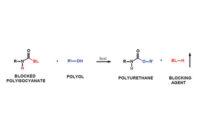I am developing a two-component reactive adhesive and need some guidance on polyol selection. Can you provide information on the performance expectations of different polyol components?
The variety of hydroxyl-containing raw materials contributes to the range of performance characteristics that can be achieved with polyurethane chemistry. Typical performance characteristics that can be varied include functionality, the components in the polyol backbone and molecular weight.Polyether polyols are made by polymerizing propylene oxide (PO) and/or ethylene oxide (EO). The functionality of the polyol is determined by the functionality of the “starter” molecule upon which the polymerization is initiated. This starter molecule is typically an alcohol or an amine. A polyol that is based solely on PO will tend to be more hydrophobic than a polyol that contains a high amount of EO. The PO-based product will have a secondary hydroxyl reactive group. It will react more slowly than an EO-capped polyol, which has a primary hydroxyl group. The polymer end group is a key factor when formulating a two-component adhesive since it has a strong influence on the curing rate of the finished product.
The molecular weight of the polyol is one of most important factors influencing performance. As the molecular weight of the polyol is increased, the polymer backbone becomes softer. The typical molecular weight for tri-functional polyether polyols used to make flexible polyurethanes ranges from 3,000-6,000 g/mol. High-molecular-weight di-functional polyols most often have a molecular weight from 2,000-4,000 g/mol, but specialty types are offered with higher molecular weights (6,000-8,000 g/mol). The backbone of these materials is most often based on propylene oxide and they are frequently EO-capped. Lower molecular weight diols and triols are made with a molecular weight between 200-1,000 g/mol. As the molecular weight decreases, the polymer tends to become harder.
The average functionality of the polyol blend and the isocyanate determines the crosslink density of the adhesive. A formulation that uses a high proportion of a low-molecular-weight triol will produce an amorphous polymer that is highly crosslinked and may be hard and brittle. An adhesive of this type would not be able to absorb stresses put on the bondline during use. A balance needs to be found between molecular weight and functionality to generate an adhesive with optimum performance. -Jeffrey F. Dormish, Ph.D.
I need a fast-curing, high-performance coating. Our manufacturing equipment is designed for handling waterborne systems. What can you recommend?
UV-curing polyurethane coatings offer high performance and fast curing. As such, there has been an overall increase in the use of UV curing applications. In certain instances, traditional 100%-solids systems are now being replaced with systems built on water-based UV-cure polyurethane dispersions (PUDs). These dispersions were developed along the same lines as the more traditional PUDs, but they contain UV-active polyester, epoxy or polyether arcrylate segments in the backbone of the polymer.This new class of UV technology offers several benefits, including extremely low co-solvent formulations, high-molecular-weight polymers (as supplied), extremely low oxygen inhibition and ease of developing low-gloss coatings. In addition, they offer the handling advantages of being a one-component system.
With the inherent flexibility of polyurethane chemistry, one can dial-in performance characteristics tailored to market needs, from mechanical and chemical resistance to soft touch applications. Certain products can be recycled in the case of overspray. However, as with many waterborne products, one must remove water prior to the curing reaction.
UV-cure PUDs are being used in many coating market areas, such as wood furniture, overprint varnishes, plastics and PVC flooring, as well as soft touch applications. UV-cure PUDs have also been found to work very well in vacuum-forming applications where a PUD-coated plastic part is dried, vacuum formed and then UV cured.
Some exciting new developments for UV PUDs are in the sunshine-cure area. The polymerization is possible through the use of photoinitiators that are activated in the visible light spectrum. This technology has the potential for coating wood decks and other “outside” applications, including those in the aerospace sector. -Michael Dvorchak
For additional information on the topics addressed or to ask another question, email jeff.dormish@bayer.com with the subject line "Polyurethane Q&A."
Any views or opinions expressed in this column are those of the author and do not represent those of Adhesives & Sealants Industry, its staff, Editorial Advisory Board or BNP Media.


